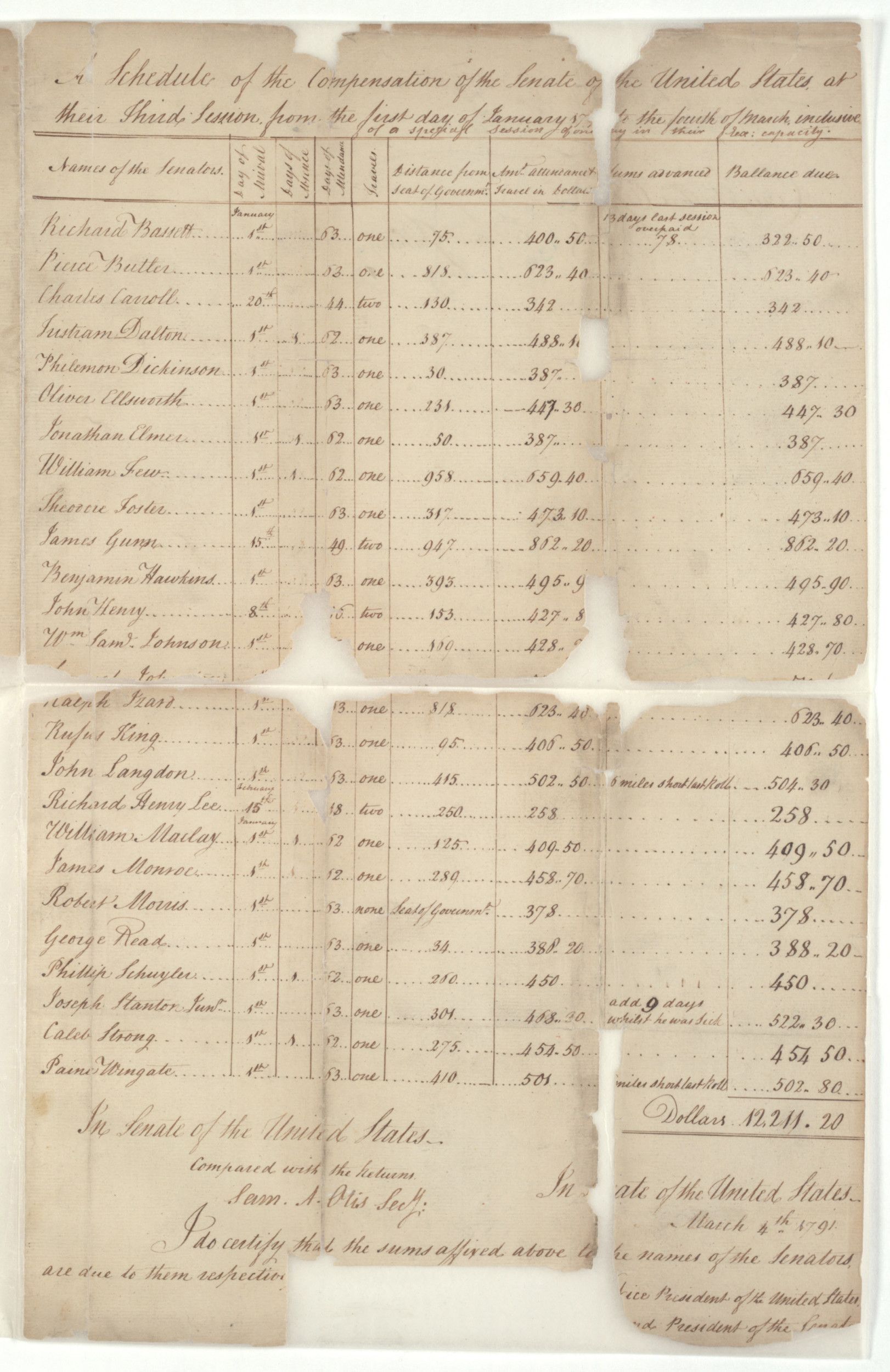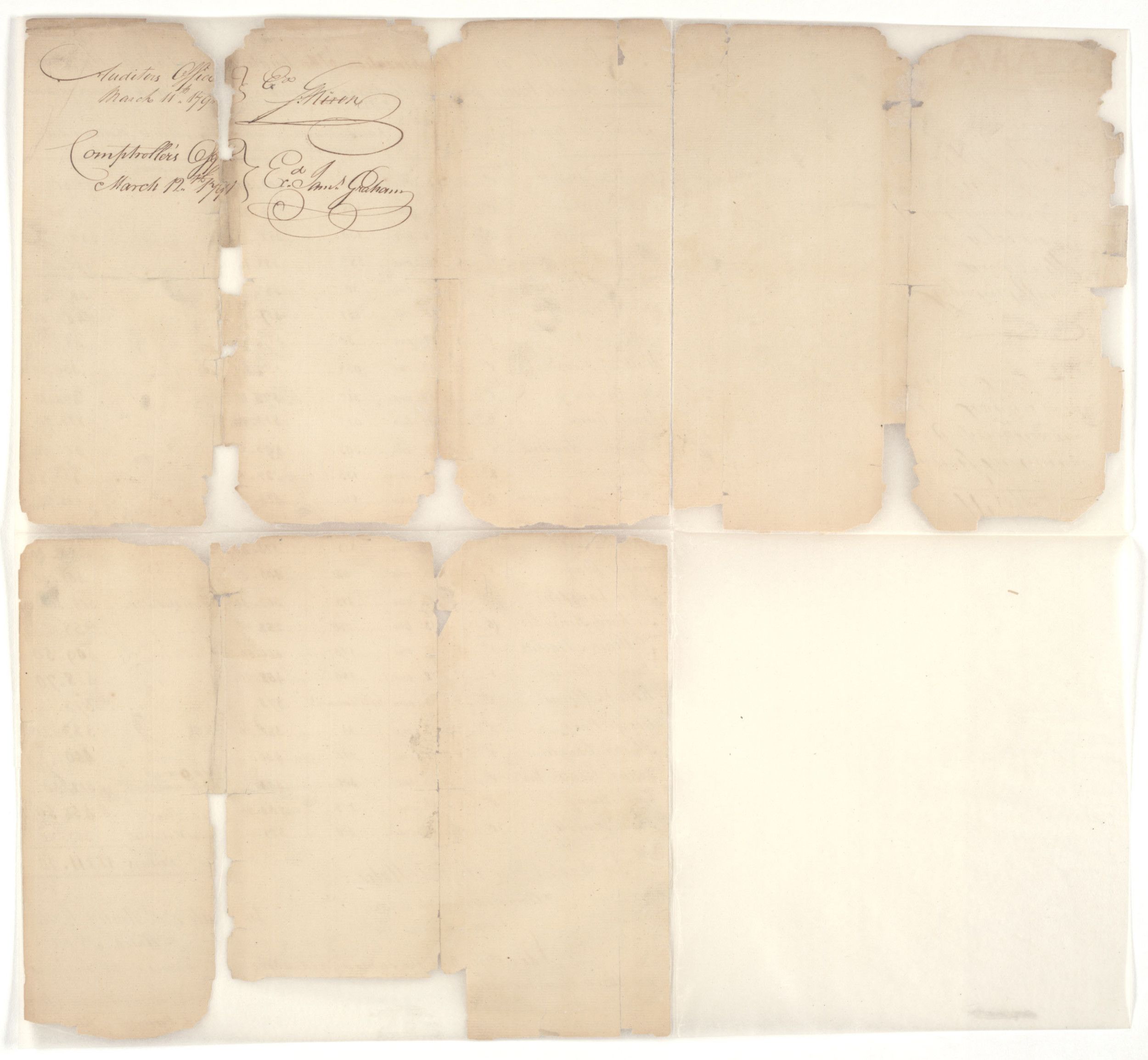Senators' Pay in the First Congress
Interpreting Data
All documents and text associated with this activity are printed below, followed by a worksheet for student responses.Introduction
From 1791-1815, members of Congress earned a daily salary and were compensated for the distance they traveled to and from the nation's capital. Use this 1791 U.S. Treasury document to calculate Senators' rate of pay and the amount they were given per mile. At this time, the capital was located in Philadelphia, PA.Examine this document as a whole, then look at your three tasks and use the "+ Add Text" button to put your answers on the document. Then "consider the source" by answering the questions below the document.
Name:
Class:
Class:
Worksheet
Senators' Pay in the First Congress
Interpreting Data
Examine the document or documents below. Use the numbers to refer to the questions or hints provided. Then label the documents(s) with additional numbers or symbols based if you were asked to do in the introduction and explain them in the margins. Write your conclusion response in the space provided.
1
2
3
Number: 1
Task 2: Because the senator you found in Task 1 did not have to travel, the total amount he received (listed in the "Balance Due" column) was based only on his daily salary. Question: Dividing his total "Balance Due" by his "Days of Attendance," how much was he paid per day? How to Answer: Click "Add Text" and move the box icon to the spot on document where you found your information. Click the icon and enter your answer in the blank text box and click save.
Number: 2
Task 3: Remember how much senators were paid per day. By multiplying that number by the number of days a Senator attended, then subtracting this from his "Balance Due," you can find out how much he was paid for travel. Question: How much was Senator William Few paid for his travel? How to Answer: Click "Add Text" and move the box icon to the spot on document where you found your information. Click the icon and enter your answer in the blank text box and click save.
Number: 3
Task 1: Senators were paid a daily salary and an amount for the number of miles they travelled to the capital - referred to on this document as the "seat of government." Question: Which senator resided at the "seat of government?" How to Answer: Click "Add Text" and move the box icon to the spot on document where you found your information. Click the icon and enter your answer in the blank text box and click save.
1
Activity Element
A Schedule of the Compensation of the Senate of the United States at their Third Session from the First Day of January 1791 to the Fourth of March
Page 2

Consider the Source
How do you think this data was collected?
Survey
Observation
Measurement
Interview
Tally or Count
Reporting or recording
Compilation from other sources
Who do you think created the document(s)?
Why do you think the document(s) were created?
What questions does this raise in your mind?
Conclusion
Senators' Pay in the First Congress
Interpreting Data
Answer the following questions:- Who's job do you think it was to decide Senators' rate of pay?
- What arguments or topics do you think came up in discussion about this decision?
Your Response
Document
A Schedule of the Compensation of the Senate of the United States at their Third Session from the First Day of January 1791 to the Fourth of March
1/1/1791 - 3/4/1791
This chart, titled "A Schedule of the Compensation of the Senate of the United States at their Third Session from the First Day of January 1791 to the Fourth of March," shows the balance due to each Senator during the first Congress. Senators were paid a stipend of $6 per day served in Congress, plus $6 for every 20 miles traveled to the "seat of government."
During the June 2, 1787, session of the Constitutional Convention, the Convention had agreed that the people's representatives would be paid — but the exact amount would be determined by the first Congress. Some members of the Constitutional Convention, such as Pennsylvania delegate Gouverneur Morris and John Langdon of New Hampshire, had voiced practical concern over the rate of pay. They argued that states at a great distance from the capital would bear an added burden in travel expenses for their representatives and senators.
During the June 2, 1787, session of the Constitutional Convention, the Convention had agreed that the people's representatives would be paid — but the exact amount would be determined by the first Congress. Some members of the Constitutional Convention, such as Pennsylvania delegate Gouverneur Morris and John Langdon of New Hampshire, had voiced practical concern over the rate of pay. They argued that states at a great distance from the capital would bear an added burden in travel expenses for their representatives and senators.
Text adapted from “Draft of the U.S. Constitution (August 1787) and Schedule of the Compensation of the Senate of the United States (March 1791)” in the January/February 2011 National Council for the Social Studies (NCSS) publication Social Education.
This primary source comes from the Records of the Accounting Officers of the Department of the Treasury, 1775 - 1978.
National Archives Identifier: 5641592
Full Citation: A Schedule of the Compensation of the Senate of the United States at their Third Session from the First Day of January 1791 to the Fourth of March; 1/1/1791 - 3/4/1791; Account 1078; Settled Treasury Accounts, 9/6/1790 - 9/29/1894; Records of the Accounting Officers of the Department of the Treasury, 1775 - 1978, ; National Archives Building, Washington, DC. [Online Version, https://docsteach.org/documents/document/senate-pay-chart, April 18, 2024]A Schedule of the Compensation of the Senate of the United States at their Third Session from the First Day of January 1791 to the Fourth of March
Page 1

A Schedule of the Compensation of the Senate of the United States at their Third Session from the First Day of January 1791 to the Fourth of March
Page 2

A Schedule of the Compensation of the Senate of the United States at their Third Session from the First Day of January 1791 to the Fourth of March
Page 3




